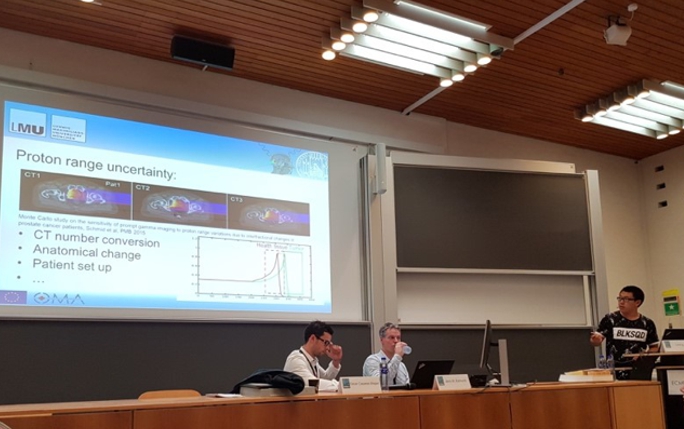Latest results on Proton Range verification via Prompt Gamma Imag-ing presented at the European Congress of Medical Physics

The latest results of Liheng’s research on prompt gamma (PG) imaging for proton beam monitoring have been presented at the European Congress of Medical Physics, in Copenhagen Denmark, August 2018.
Proton beams show considerable advantages in the field of radiation therapy for treating certain cancers due to the energy deposition peak at the end of their range. However, due to several factors, proton therapy exhibits uncertainties so it is vital that the beam is monitored during patient treatment. One of the most promising approaches, prompt gamma (PG) imaging, can enable in-vivo monitoring of the proton range.
The accuracy and precision of PG measurements are affected by both tissue heterogeneities and counting statistics. These effects are not considered in current treatment planning systems (TPS). To investigate the possibility of re-optimizing TPS accounting for in-vivo proton range monitoring, Monte Carlo treatment plans (initial plans) for 3 head and neck patients were firstly created using a research computational platform, combining Monte Carlo (Geant4) pre-calculated pencil beams with the analytical Matlab-based TPS engine CERR (a Computational Enviroment for Radiotherapy Research).
Data analysis showed that the re-optimized plan is comparable to the initial plan in terms of dose distribution, dose averaged linear energy transfer (LET) distribution and plan robustness, while fulfilling the conditions for reliable PG monitoring. With the results of this project, the in-vivo PG range verification method is taken into account in the treatment planning process for the first time, potentially contributing to a future reduction of range uncertainties in proton therapy.
The research has been published: Toward a new treatment planning approach accounting for in vivo proton range verification, Liheng Tian et al 2018 Phys. Med. Biol. 63 215025